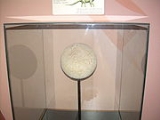
Saltasaurus
Overview
Genus
In biology, a genus is a low-level taxonomic rank used in the biological classification of living and fossil organisms, which is an example of definition by genus and differentia...
of titanosaurid sauropod dinosaur
Dinosaur
Dinosaurs are a diverse group of animals of the clade and superorder Dinosauria. They were the dominant terrestrial vertebrates for over 160 million years, from the late Triassic period until the end of the Cretaceous , when the Cretaceous–Paleogene extinction event led to the extinction of...
of the Late Cretaceous
Cretaceous
The Cretaceous , derived from the Latin "creta" , usually abbreviated K for its German translation Kreide , is a geologic period and system from circa to million years ago. In the geologic timescale, the Cretaceous follows the Jurassic period and is followed by the Paleogene period of the...
Period. Relatively small among sauropods, though still massive by the standards of modern creatures, Saltasaurus was characterized by a diplodocid
Diplodocid
Diplodocids, or members of the family Diplodocidae , are a group of sauropod dinosaurs. The family includes some of the longest creatures ever to walk the earth, including Diplodocus and Supersaurus, which may have reached lengths of up to .-Description:While still massive, when compared to the...
-like head (with blunt teeth, only in the back of the mouth). It was the first genus of sauropod known to possess armour
Armour (zoology)
Armour in animals is external or superficial protection against attack by predators, formed as part of the body , usually through the hardening of body tissues, outgrowths or secretions. It has therefore mostly developed in 'prey' species...
of bony plates embedded in its skin. The small bony plates (called osteoderms, a feature of modern crocodile
Crocodile
A crocodile is any species belonging to the family Crocodylidae . The term can also be used more loosely to include all extant members of the order Crocodilia: i.e...
s) have since been found on other titanosaurids.
Unanswered Questions

